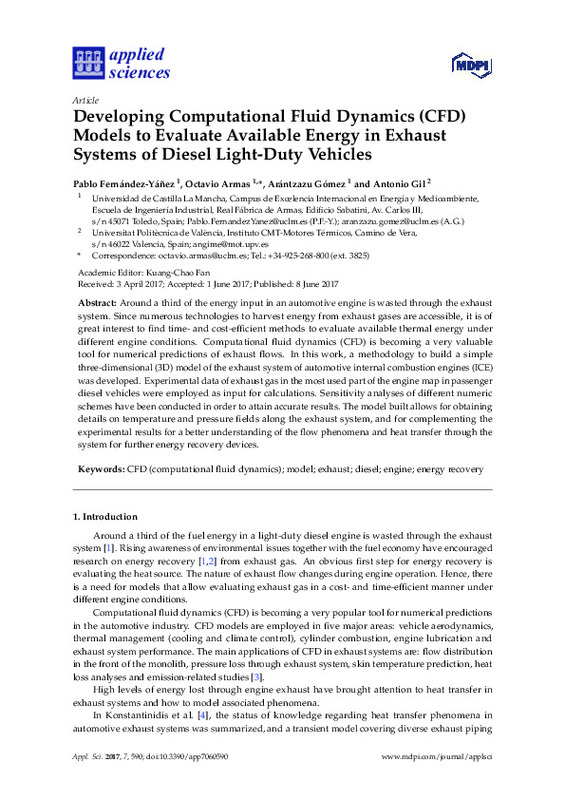Hossain, S. N., & Bari, S. (2014). Waste Heat Recovery from Exhaust of a Diesel Generator Set Using Organic Fluids. Procedia Engineering, 90, 439-444. doi:10.1016/j.proeng.2014.11.753
Galindo, J., Dolz, V., Royo-Pascual, L., Haller, R., & Melis, J. (2016). Modeling and Experimental Validation of a Volumetric Expander Suitable for Waste Heat Recovery from an Automotive Internal Combustion Engine Using an Organic Rankine Cycle with Ethanol. Energies, 9(4), 279. doi:10.3390/en9040279
Zhang, X., & Romzek, M. (2008). Computational Fluid Dynamics (CFD) Applications in Vehicle Exhaust System. SAE Technical Paper Series. doi:10.4271/2008-01-0612
[+]
Hossain, S. N., & Bari, S. (2014). Waste Heat Recovery from Exhaust of a Diesel Generator Set Using Organic Fluids. Procedia Engineering, 90, 439-444. doi:10.1016/j.proeng.2014.11.753
Galindo, J., Dolz, V., Royo-Pascual, L., Haller, R., & Melis, J. (2016). Modeling and Experimental Validation of a Volumetric Expander Suitable for Waste Heat Recovery from an Automotive Internal Combustion Engine Using an Organic Rankine Cycle with Ethanol. Energies, 9(4), 279. doi:10.3390/en9040279
Zhang, X., & Romzek, M. (2008). Computational Fluid Dynamics (CFD) Applications in Vehicle Exhaust System. SAE Technical Paper Series. doi:10.4271/2008-01-0612
Konstantinidis, P. A., Koltsakis, G. C., & Stamatelos, A. M. (1997). Transient heat transfer modelling in automotive exhaust systems. Proceedings of the Institution of Mechanical Engineers, Part C: Journal of Mechanical Engineering Science, 211(1), 1-15. doi:10.1243/0954406971521610
Kandylas, I. P., & Stamatelos, A. M. (1999). Engine exhaust system design based on heat transfer computation. Energy Conversion and Management, 40(10), 1057-1072. doi:10.1016/s0196-8904(99)00008-4
Guardiola, C., Dolz, V., Pla, B., & Mora, J. (2016). Fast estimation of diesel oxidation catalysts inlet gas temperature. Control Engineering Practice, 56, 148-156. doi:10.1016/j.conengprac.2016.08.020
Shayler, P. J., Hayden, D. J., & Ma, T. (1999). Exhaust System Heat Transfer and Catalytic Converter Performance. SAE Technical Paper Series. doi:10.4271/1999-01-0453
Kapparos, D. J., Foster, D. E., & Rutland, C. J. (2004). Sensitivity Analysis of a Diesel Exhaust System Thermal Model. SAE Technical Paper Series. doi:10.4271/2004-01-1131
Fu, H., Chen, X., Shilling, I., & Richardson, S. (2005). A One-Dimensional Model for Heat Transfer in Engine Exhaust Systems. SAE Technical Paper Series. doi:10.4271/2005-01-0696
Fortunato, F., Caprio, M., Oliva, P., D’Aniello, G., Pantaleone, P., Andreozzi, A., & Manca, O. (2007). Numerical and Experimental Investigation of the Thermal Behavior of a Complete Exhaust System. SAE Technical Paper Series. doi:10.4271/2007-01-1094
Liu, X., Deng, Y. D., Zhang, K., Xu, M., Xu, Y., & Su, C. Q. (2014). Experiments and simulations on heat exchangers in thermoelectric generator for automotive application. Applied Thermal Engineering, 71(1), 364-370. doi:10.1016/j.applthermaleng.2014.07.022
Hamedi, M. R., Tsolakis, A., & Herreros, J. M. (2014). Thermal Performance of Diesel Aftertreatment: Material and Insulation CFD Analysis. SAE Technical Paper Series. doi:10.4271/2014-01-2818
Voltz, S. E., Morgan, C. R., Liederman, D., & Jacob, S. M. (1973). Kinetic Study of Carbon Monoxide and Propylene Oxidation on Platinum Catalysts. Industrial & Engineering Chemistry Product Research and Development, 12(4), 294-301. doi:10.1021/i360048a006
Oh, S. H., & Cavendish, J. C. (1982). Transients of monolithic catalytic converters. Response to step changes in feedstream temperature as related to controlling automobile emissions. Industrial & Engineering Chemistry Product Research and Development, 21(1), 29-37. doi:10.1021/i300005a006
Dubien, C., Schweich, D., Mabilon, G., Martin, B., & Prigent, M. (1998). Three-way catalytic converter modelling: fast- and slow-oxidizing hydrocarbons, inhibiting species, and steam-reforming reaction. Chemical Engineering Science, 53(3), 471-481. doi:10.1016/s0009-2509(97)00313-8
Koltsakis, G. C., Konstantinidis, P. A., & Stamatelos, A. M. (1997). Development and application range of mathematical models for 3-way catalytic converters. Applied Catalysis B: Environmental, 12(2-3), 161-191. doi:10.1016/s0926-3373(96)00073-2
Wurzenberger, J. C., Wanker, R., & Schüßler, M. (2008). Simulation of Exhaust Gas Aftertreatment Systems - Thermal Behavior During Different Operating Conditions. SAE Technical Paper Series. doi:10.4271/2008-01-0865
Guojiang, W., & Song, T. (2005). CFD simulation of the effect of upstream flow distribution on the light-off performance of a catalytic converter. Energy Conversion and Management, 46(13-14), 2010-2031. doi:10.1016/j.enconman.2004.11.001
Hayes, R. E., Fadic, A., Mmbaga, J., & Najafi, A. (2012). CFD modelling of the automotive catalytic converter. Catalysis Today, 188(1), 94-105. doi:10.1016/j.cattod.2012.03.015
Chatterjee, D., Deutschmann, O., & Warnatz, Jã¼. (2001). Detailed surface reaction mechanism in a three-way catalyst. Faraday Discussions, 119(1), 371-384. doi:10.1039/b101968f
Kumar, R., Sonthalia, A., & Goel, R. (2011). Experimental study on waste heat recovery from an IC engine using thermoelectric technology. Thermal Science, 15(4), 1011-1022. doi:10.2298/tsci100518053k
Pong, H., Wallace, J., & Sullivan, P. E. (2012). Modeling of Exhaust Gas Treatment for Stationary Applications. SAE Technical Paper Series. doi:10.4271/2012-01-1300
Cárdenas, M. D., Armas, O., Mata, C., & Soto, F. (2016). Performance and pollutant emissions from transient operation of a common rail diesel engine fueled with different biodiesel fuels. Fuel, 185, 743-762. doi:10.1016/j.fuel.2016.08.002
Andrade, J. S., Costa, U. M. S., Almeida, M. P., Makse, H. A., & Stanley, H. E. (1999). Inertial Effects on Fluid Flow through Disordered Porous Media. Physical Review Letters, 82(26), 5249-5252. doi:10.1103/physrevlett.82.5249
Benjamin, S. F., Liu, Z., & Roberts, C. A. (2004). Automotive catalyst design for uniform conversion efficiency. Applied Mathematical Modelling, 28(6), 559-572. doi:10.1016/j.apm.2003.10.008
Mladenov, N., Koop, J., Tischer, S., & Deutschmann, O. (2010). Modeling of transport and chemistry in channel flows of automotive catalytic converters. Chemical Engineering Science, 65(2), 812-826. doi:10.1016/j.ces.2009.09.034
Patankar, S. ., & Spalding, D. . (1972). A calculation procedure for heat, mass and momentum transfer in three-dimensional parabolic flows. International Journal of Heat and Mass Transfer, 15(10), 1787-1806. doi:10.1016/0017-9310(72)90054-3
Shih, T.-H., Liou, W. W., Shabbir, A., Yang, Z., & Zhu, J. (1995). A new k-ϵ eddy viscosity model for high reynolds number turbulent flows. Computers & Fluids, 24(3), 227-238. doi:10.1016/0045-7930(94)00032-t
Agudelo, A. F., García-Contreras, R., Agudelo, J. R., & Armas, O. (2016). Potential for exhaust gas energy recovery in a diesel passenger car under European driving cycle. Applied Energy, 174, 201-212. doi:10.1016/j.apenergy.2016.04.092
Launder, B. E., & Spalding, D. B. (1974). The numerical computation of turbulent flows. Computer Methods in Applied Mechanics and Engineering, 3(2), 269-289. doi:10.1016/0045-7825(74)90029-2
[-]









